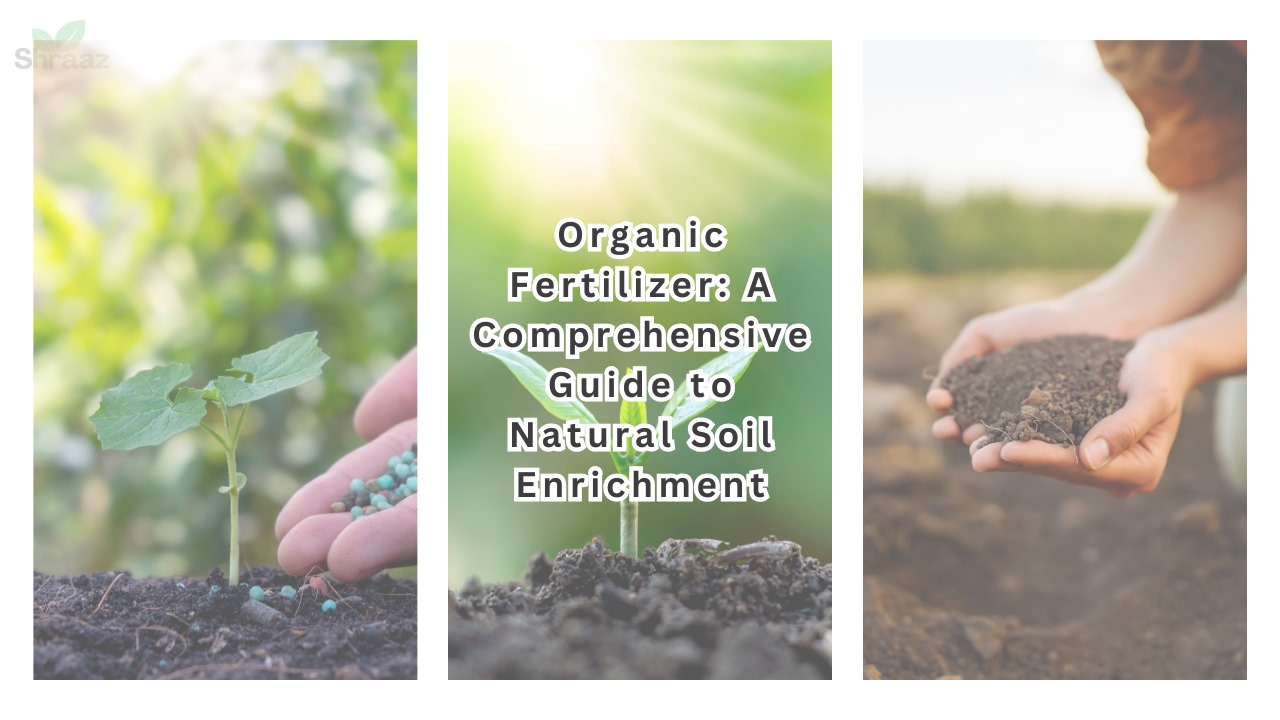Introduction to Organic Fertilizer
Organic fertilizer is becoming increasingly important in the global shift toward sustainable agriculture. As concerns about environmental degradation, soil health, and food security grow, organic fertilizers offer an alternative to synthetic, chemical-based products. Derived from plant, animal, and mineral sources, organic fertilizers improve soil structure, provide essential nutrients, and promote healthy plant growth. In contrast to their synthetic counterparts, organic fertilizers enhance soil biodiversity and prevent the harmful buildup of chemicals.
The rising global demand for organic food and sustainable farming methods is pushing many farmers, gardeners, and consumers to reconsider the long-term benefits of using natural products. In this article, we will explore the types, benefits, and challenges of organic fertilizers, discuss their role in sustainable agriculture, and look at future trends in the industry.
For a broader discussion of the overall organic products beyond just fertilizer, check out The Ultimate Guide to Organic Products: Health, Benefits, and Industry Insights.
What is Organic Fertilizer?
Organic fertilizer is derived from natural sources such as animal manure, plant residues, or naturally occurring minerals. Unlike synthetic fertilizers, which are chemically manufactured to provide specific nutrients in concentrated forms, organic fertilizers release nutrients slowly as they decompose, allowing for a more sustained nutrient supply to plants and soil.
Key Characteristics of Organic Fertilizers:
- Natural Origin: Made from plant, animal, or mineral sources.
- Slow Nutrient Release: Organic fertilizers release nutrients gradually as they break down, which prevents nutrient leaching and reduces the risk of over-fertilization.
- Environmental Benefits: Organic fertilizers help maintain soil health, enhance soil biodiversity, and reduce pollution from synthetic chemicals.
Synthetic vs. Organic Fertilizers
| Feature | Synthetic Fertilizers | Organic Fertilizers |
| Source | Chemically manufactured | Derived from natural materials |
| Nutrient Availability | Immediate, quick-release | Slow, sustained release |
| Environmental Impact | Can lead to pollution (runoff, chemical buildup) | Minimal pollution promotes biodiversity |
| Soil Health | Can degrade soil structure over time | Improves soil structure and health |
| Cost | Generally lower cost upfront | Higher initial cost, long-term benefits |
Types of Organic Fertilizers
There are several types of organic fertilizers, each with different nutrient profiles and benefits for the soil and plants. These fertilizers are typically divided into animal-based, plant-based, and mineral-based categories.
Animal-Based Organic Fertilizers
These fertilizers are rich in nitrogen, phosphorus, and potassium (N-P-K) and are derived from the byproducts of animals.
- Manure:
- Animal manure (e.g., cow, chicken, horse) is one of the most common organic fertilizers.
- Nutrient Content: This varies depending on the animal source but typically contains a balance of nitrogen, phosphorus, and potassium.
- Benefits: Improves soil structure, and increases microbial activity.
- Bone Meal:
- It is made from ground animal bones, rich in phosphorus.
- Nutrient Content: 3-15% phosphorus, some nitrogen.
- Benefits: Encourages root development, especially beneficial for flowering plants.
- Blood Meal:
- Derived from dried animal blood, a rich source of nitrogen.
- Nutrient Content: 12-15% nitrogen.
- Benefits: Promotes leafy growth, great for nitrogen-hungry plants like spinach and lettuce.
- Fish Emulsion:
- Liquid fertilizer made from decomposed fish.
- Nutrient Content: High in nitrogen, some phosphorus, and potassium.
- Benefits: Fast-acting, boosts overall plant health.
Plant-Based Organic Fertilizers
Plant-based fertilizers decompose quickly and are great for enhancing soil organic matter.
- Compost:
- Made from decomposed organic materials like food waste and yard clippings.
- Nutrient Content: Variable, depends on input material.
- Benefits: Improves soil structure, adds humus, and encourages microbial life.
- Green Manure:
- Cover crops (e.g., clover, alfalfa) are grown and then plowed back into the soil.
- Benefits: Adds nitrogen, improves soil fertility, and prevents erosion.
- Alfalfa Meal:
- Made from ground alfalfa, rich in nitrogen and trace minerals.
- Nutrient Content: 3% nitrogen, 2% phosphorus, 2% potassium.
- Benefits: Promotes root growth and biological activity in the soil.
- Seaweed/Kelp:
- Derived from ocean plants, rich in trace minerals and growth hormones.
- Benefits: Enhances stress resistance in plants, and promotes root and overall growth.
Mineral-Based Organic Fertilizers
These are naturally occurring mineral substances that provide essential nutrients to plants.
- Rock Phosphate:
- A mined mineral that is a natural source of phosphorus.
- Benefits: Slow-release phosphorus, great for root development.
- Wood Ash:
- A byproduct of burning wood, rich in potassium.
- Nutrient Content: High in potassium, also contains calcium and magnesium.
- Benefits: Increases soil pH (alkaline), good for soils that are too acidic.
- Guano:
- Bat or bird droppings are rich in nitrogen and phosphorus.
- Benefits: Provides fast nutrient availability, and supports vigorous plant growth.
How Organic Fertilizer Works
Organic fertilizers improve soil health by introducing organic matter and enhancing the natural nutrient cycle. They work by being broken down by soil microorganisms, releasing nutrients slowly over time.
Nutrient Release Mechanism
Unlike synthetic fertilizers, which provide nutrients in a soluble form for immediate uptake, organic fertilizers rely on microbial decomposition. As soil organisms break down the organic material, essential nutrients such as nitrogen, phosphorus, and potassium are gradually released, making them available for plant uptake.
Soil Health Benefits
- Improved Soil Structure: Organic matter helps soil particles bind together, improving aeration and water retention.
- Enhanced Microbial Activity: Organic fertilizers provide food for beneficial microorganisms, which, in turn, improve nutrient availability and protect plants from harmful pathogens.
- Long-Term Fertility: Organic fertilizers increase the amount of organic matter in the soil, which contributes to long-term soil fertility.
Benefits of Organic Fertilizer
Organic fertilizers offer numerous advantages over synthetic alternatives. While their effects may take longer to materialize, the long-term benefits to soil health, plant nutrition, and the environment are significant.
Environmental Benefits
- Reduces Chemical Runoff: Organic fertilizers decrease the risk of harmful nutrient leaching into waterways, reducing water pollution.
- Minimizes Greenhouse Gas Emissions: Manufacturing synthetic fertilizers is energy-intensive and produces greenhouse gases. Organic fertilizers, being natural byproducts, have a lower carbon footprint.
- Preserve Biodiversity: By enriching the soil’s ecosystem, organic fertilizers support diverse plant and animal life.
Sustainability in Agriculture
- Regenerative Agriculture: Organic fertilizers play a key role in practices like regenerative agriculture, which aims to restore soil health, increase biodiversity, and sequester carbon.
- Reduced Dependence on Fossil Fuels: Organic fertilizers decrease the reliance on synthetic fertilizers, which are derived from petroleum-based products.
Nutritional Benefits for Plants
- Balanced Nutrient Release: Organic fertilizers provide a slow, steady supply of nutrients, ensuring that plants receive nourishment over time.
- Enhanced Plant Quality: Studies have shown that crops grown with organic fertilizers often contain higher levels of essential nutrients, vitamins, and minerals.
Figures and Data:
- Organic fertilizers can improve soil organic matter content by up to 58%, enhancing water retention by as much as 20%, according to research by the Rodale Institute.
- In 2023, the global organic fertilizer market size was valued at $8.3 billion and is expected to grow at a 12% CAGR from 2024 to 2030.
Challenges and Considerations
While organic fertilizers provide numerous benefits, there are also challenges and considerations to keep in mind. The slow release of nutrients, potential cost, and variability in nutrient content require careful management to achieve optimal results.
Nutrient Variability
Organic fertilizers can vary widely in nutrient content depending on their source. This variability can make it difficult for farmers and gardeners to determine precise application rates.
- Compost Nutrient Content: Compost nutrient levels depend on the types of organic matter used, which can fluctuate widely.
- Animal Manure: Nutrient content varies based on the type of animal, their diet, and the method of manure collection. For example, chicken manure is high in nitrogen, while cow manure tends to be lower in nutrients but more balanced overall.
To address these issues, it’s recommended to:
- Test Soil Regularly: Soil tests help determine the nutrient needs of your crops and guide appropriate organic fertilizer application.
- Know Your Source: Understanding the nutrient content of the organic fertilizers you are using (e.g., through lab analysis or supplier data) is crucial for effective nutrient management.
Slow Nutrient Release
Organic fertilizers generally break down more slowly than synthetic fertilizers, which can be both an advantage and a challenge, depending on crop needs.
- Benefits: The slow release ensures a steady supply of nutrients, reducing the risk of nutrient leaching.
- Challenges: For plants or crops with high nutrient demands, such as leafy greens or high-yielding crops like corn, organic fertilizers may not supply nutrients quickly enough.
To compensate, some strategies include:
- Supplement with Fast-Acting Organics: Products like fish emulsion or blood meal can be used to provide a quicker nutrient boost when needed.
- Apply in Advance: Applying organic fertilizers in advance of planting allows sufficient time for decomposition and nutrient release.
Cost and Availability
Organic fertilizers can be more expensive than synthetic alternatives, especially when large quantities are required for commercial farming.
- High Cost of Processing: Producing some organic fertilizers, such as fish emulsion or bone meal, involves labor-intensive processes that drive up costs.
- Regional Availability: Some organic fertilizers, like certain types of manure or compost, may not be available in all regions, especially in urban areas where livestock farming is limited.
Storage and Handling
Organic fertilizers often require careful storage and handling to preserve their nutrient content and prevent spoilage.
- Manure and Compost: These products can lose nutrients, especially nitrogen, if stored improperly. Manure must be kept covered and in cool conditions to prevent nutrient loss through volatilization.
- Odor and Pest Attraction: Animal-based fertilizers can emit strong odors or attract pests if not stored and managed correctly.
Potential for Over-Application
Although organic fertilizers are often seen as environmentally friendly, improper application can still lead to issues like nitrogen leaching or nutrient imbalances.
- Nitrogen Leaching: Excess nitrogen from organic sources like manure can still leach into groundwater, contributing to pollution.
- Soil Imbalances: Overuse of organic fertilizers with unbalanced N-P-K ratios can create soil imbalances that affect plant health and yield.
Application Techniques
Proper application techniques are essential for maximizing the benefits of organic fertilizers and ensuring their nutrients are available to plants.
Timing of Application
The timing of organic fertilizer application can significantly impact nutrient availability and plant health.
- Pre-Planting: Organic fertilizers like compost or manure are often applied before planting to allow sufficient time for decomposition.
- In-Season Feeding: Products like liquid fish emulsion or compost tea can be used to provide an additional nutrient boost during the growing season.
Application Methods
Different types of organic fertilizers require different application methods to be most effective.
- Broadcasting: This method involves spreading fertilizers evenly across the field. It’s commonly used for applying compost, manure, or granular organic fertilizers.
- Side-Dressing: Placing organic fertilizers along the sides of growing plants allows for targeted nutrient delivery. This method is often used with nitrogen-rich fertilizers during the growth stages of crops like corn.
- Top-Dressing: Applying organic fertilizers on the soil surface around established plants can provide a slow-release nutrient supply throughout the growing season. Compost and mulch are commonly applied in this way.
Composting
One of the most effective ways to produce organic fertilizer at home is through composting. This process converts food scraps, yard waste, and other organic materials into nutrient-rich compost that improves soil health.
Types of Composting:
- Cold Composting: A slower, low-maintenance process where organic materials break down naturally over time.
- Hot Composting: Requires more effort but produces compost faster. By maintaining the proper carbon-to-nitrogen ratio, moisture, and aeration, decomposition speeds up, and the compost can be ready in as little as a few weeks.
Composting Considerations:
- Carbon-to-Nitrogen Ratio: Balancing “browns” (carbon-rich materials like dry leaves) and “greens” (nitrogen-rich materials like kitchen scraps) is essential for efficient composting.
- Aeration: Turning the compost pile regularly helps oxygenate it and speeds up the decomposition process.
The Role of Organic Fertilizers in Sustainable Agriculture
Organic fertilizers are a key component of sustainable agriculture, playing an essential role in promoting long-term soil health, biodiversity, and climate resilience.
Organic Farming Practices
In organic farming systems, synthetic fertilizers are prohibited, and organic fertilizers become the primary means of adding nutrients to the soil. Organic farming also incorporates practices such as crop rotation, cover cropping, and reduced tillage, all of which are enhanced by the use of organic fertilizers.
- Crop Rotation: Rotating different crops in the same field helps to reduce pest pressure and increase soil fertility. Organic fertilizers add essential nutrients that can be depleted by certain crops.
- Cover Cropping: Growing cover crops such as clover or alfalfa during the off-season helps to improve soil structure and fertility. When these crops are tilled back into the soil, they act as green manure, enhancing the benefits of organic fertilizers.
Climate Change Mitigation
Organic fertilizers can help mitigate climate change by reducing greenhouse gas emissions and improving the soil’s ability to sequester carbon.
- Lower Carbon Footprint: Organic fertilizers typically have a lower carbon footprint than synthetic fertilizers, which require fossil fuels for their production.
- Soil Carbon Sequestration: Increasing the organic matter in the soil through the use of compost and other organic fertilizers helps store carbon in the soil, reducing the amount of CO2 in the atmosphere.
Impact on Soil Carbon Sequestration
Research shows that increasing soil organic matter by just 1% can increase the soil’s ability to retain 20,000 gallons of water per acre. This not only improves soil fertility but also helps in water conservation, particularly in arid regions. Organic fertilizers contribute to this process by adding decomposed organic material back into the soil, which binds carbon and prevents it from being released into the atmosphere.
Future Trends in Organic Fertilizers
The organic fertilizer industry is evolving as new technologies and farming practices emerge. With growing demand for sustainable products and increased investment in agricultural innovation, the future of organic fertilizers looks promising.
Innovations in Organic Fertilizer Production
- Microbial Inoculants: These are microorganisms added to organic fertilizers to enhance nutrient availability and soil health. They promote nitrogen fixation, phosphorus solubilization, and other biological processes.
- Biochar: A form of charcoal made from organic waste, biochar is used to improve soil structure and nutrient retention. It can also act as a carbon sink, making it an important tool in the fight against climate change.
Market Trends and Consumer Demand
The global organic fertilizer market is expected to grow significantly over the next decade, driven by increased consumer demand for organic food and sustainable farming practices. Governments worldwide are also providing incentives for organic farming, further boosting the market.
- Market Size: The global organic fertilizer market was valued at $8.3 billion in 2023 and is projected to grow at a compound annual growth rate (CAGR) of 12% from 2024 to 2030.
- Government Policies: Many countries are implementing policies to encourage organic farming, including subsidies, tax incentives, and organic certification programs.
Potential for Urban Agriculture
As urban populations grow, so does the interest in urban agriculture. Organic fertilizers can play a significant role in this trend, providing a sustainable nutrient source for rooftop gardens, community plots, and vertical farming systems.
- Waste Recycling: Food waste composting programs in cities are increasingly providing organic fertilizers for urban farmers, helping to reduce waste and improve local food systems.
- Vertical Farming: Organic fertilizers are being used in vertical farming systems to provide nutrients to plants grown in stacked layers, optimizing space and resources in urban environments.
Conclusion
Organic fertilizers are essential tools for sustainable agriculture, providing numerous environmental, economic, and nutritional benefits. While they come with challenges, such as cost and nutrient variability, their long-term impact on soil health and environmental sustainability far outweigh the drawbacks. As the demand for organic farming and sustainable food production grows, organic fertilizers will continue to play a critical role in ensuring food security and environmental resilience.
Additional Resources/References
- Rodale Institute: Research on the benefits of organic fertilizers and regenerative agriculture.
- Organic Farming Research Foundation: Information on organic farming practices and organic certification.
- USDA Organic: Guidelines for organic certification and the use of organic fertilizers in farming.




